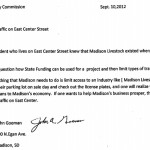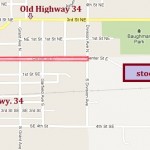Last week 29 residents of East Center Street in Madison signed and submitted to the Madison City Commission a letter asking that the city prohibit truck traffic on their newly reconstructed street. East Center most directly connects Highway 34 and the Madison stockyard. From Washington Avenue, the two-lane street runs through an entirely residential neighborhood, with a park, playground, and hockey rink east of Garfield Avenue.
This week the Madison City Commission acknowledges letters from two loci of Madison power, John Goeman and the Chamber of Commerce, who oppose truck restrictions on East Center Street. Chamber director Rosie Jamison simply expresses her board's opinion that since Madison Livestock Sales Co. (a dues-paying member of the Chamber of Commerce) "provides significant commerce to our community," its customers ought to be able to use East Center to conduct their business.
John Goeman's letter provides a little more amusement. He opens by telling East Center residents to quit complaining. "Any resident who lives on East Center Street knew that Madison Livestock existed before they bought their home," says Goeman, positing the notion that if you buy a house, you are obliged to accept the sale-time conditions of that neighborhood exactly the way they are, forever. Homeowners can never work for improvements or changes in their neighborhoods.
Second, Goeman questions whether the city can use state funding to fix a street and then limit types of traffic on it. Hmm... it looks to me as if the city can do that under South Dakota Codified Law 32-14-7, which allows local authorities to prohibit trucks and other commercial vehicles from designated highways. I see no conditions making that authority dependent on funding sources.
Goeman wraps up by turning to the same pro-business contention as the Chamber. He says that if we want Madison to "prosper," we can't limit traffic on East Center. Now of course, we're not talking "prospering"; we're just talking maintaining the status quo. And East Center residents aren't talking about shutting down the stockyard; they're talking about diverting semis out of a residential area that saw its street pulverized by heavy commercial traffic over the last several years. Let's take a look at the map, courtesy of Google:
If the city granted East Center residents' request, folks hauling livestock from west of Madison would come in to town on Highway 34, as usual. Then, instead of turning south on 34 at Washington, they'd continue east on Old 34, which has four lanes. They'd turn south at Division Avenue, pass through three fewer blocks of residential area, then turn east to the stockyards on the that last gravel spur of East Center. They'll hardly notice the extra block of mileage caused by taking that little curve on Old 34. Plus, they won't have to execute that quick lane change at the Washington intersection, where, if they are driving properly (and you all do this, right?), they stay in the far right lane as they turn, they switch to the left lane, then switch to the turning lane, all within two quick blocks in a big truck.
Folks hauling livestock from south and east of town would face the biggest detour. They'd come up Highway 34 from Prostrollo's, then, instead of turning at Center, would have to go two blocks further north to Old 34. They get four blocks of extra grief.
Of course, folks hauling critters from the north and east may face no detour. If they're already coming in on Old 34, they're already taking Division to the stockyard.
If Madison's prosperity hinges on sparing a few dozen trucks a week a four-block detour on a wider, safer road, then Madison needs to diversify its economy.
It's worth noting that John Goeman has been one of the prime boosters behind the "Four for the Future" campaign to widen Highway 34 east of Madison to four lanes. One of the main contentions Goeman and backers have made for this massive expenditure of tax dollars is that a four-lane highway would be much safer with all the ag-related traffic on 34. The residents of East Center are asking the city to divert ag-related traffic to a four-lane road. Goeman's letter shows that business is a more important consideration in his highway calculus than safety.






The city invested quite a bit in the east Center Street project and took into consideration the truck traffic when designing the road. One question to ask, however, is whether this particular stretch of Division Avenue would be suitable for truck traffic. I believe it's a lightly paved road from one direction and gravel coming from the other direction. Updating that road would have to be taken into consideration first before excluding truck traffic from Center St.
That's a good point, Elisa! Is the East Center concrete thicker for trucks? Is the street wider? And did anyone raise the question of blocking trucks from this street before they started digging?
In fact, East Center was built to carry the current load of trucks, as per the traffic counts during the design phase, two years ago. Corners were re-radiused to ease trucks turning off of Washington Ave and onto Center. As the Sale Barn only operates on Monday, and some Saturdays in the winter and early spring, it's not a constant stream of truck traffic by any means.
Also, the concerned citizens didn't mention a safety concern, noise, traffic or any other reason.. just that they didn't want trucks using the street. There are two warehouses that also utilize that street (Montgomery Furniture and Barger Electric), and both City garbage trucks and Bud's Clean-up.. It would be almost impossible to ban livestock semi's on a road wear factor, while still allowing everyone else to use the street. Just my opinion..
It seems very odd to plan and encourage truck traffic through a residential area. Although those concerned citizens didn't mention the specifics isn't it obvious those would be their concerns? We don't have any choice with garage trucks. Someone I know that lives on this street told me they were given no notice the street was going to be redone so it seems difficult for them to have raised the concerns prior to the improvements. If the trucks were going by our house we would see it similarly. Occasionally we have semi trucks on Lincoln Avenue near the college and it's feel dangerous.
John, you don't want trucks through a residential area but the last time I looked coming from north division was also going through a residential area. Maybe the city should just condem the livestock barn and then the farmers could do their business someplace else other than Madison when they have livestock to sell.
I was thinking, Gary, that the stockyard has a rotten location. Would the stockyard benefit from moving to a different, more accessible location, like out by the elevator west of town, or in the Industrial Park on 34 on the east edge of town? Or maybe south from Prostrollos, across from Custom Touch?
True, but for a much shorter block. Gary, I didn't see anywhere, anyone asking for a business to be condemned. If you think it's a good idea go ahead and present that as your own, with your full name.
Homeowners can never work for improvements or changes in their neighborhoods.
So existing salebarns can work to improve their neighborhoods by getting the city to prohibit chemical fertilyzers on homewners' lawns in favor of natural "compost" produced by the salebarn? If homeowners can try to get a city to regulate existing salebarns, can the salebarn try to get the city to restrict homeowners' uses?
I was thinking that these homeowners live in a rotten location. (nevermind that they knew it!) Maybe they should up and leave for a better place in another part of the county where there's not so much ag activity. Or maybe they should get to their houses in a roundabout way when the city closes certain streets around their houses to non-truck traffic.
Or are we just in the mood of telling businesses what they should be doing, not homeowners who moved to the nuisance?
John, it is not a block it is two blocks. Everyone seems to forget that when the sale barn was built it WAS outside of town but as Madison grew they built their homes closer to the sale barn so now it is a problem that the sale barn had nothing to do with or caused. No I do not want the city to condem the sale barn but that is in effect what you are doing when you put more restrictions on access to a very viable business.
Where I may not necessarily agree with John Goeman, I do agree that all of these people knew where the sale barn was and knew about the traffic when they bought their homes on this street, that is unless they were living their when the sale barn was built!
Cory, it wasn't a rotten location when it was built. Highway 34 was a main thorough fare and that was a good location. How were the founders of the sale barn to forsee that there would be a new highway 34 and that the city would grow toward them when it was built. It may be a terrible location now but was an excellent location when it was built.
If you want to see a modern day example of what happened look at the soybean plant in Volga. When it was built it was a half mile away from the city of Volga but I am just waiting for some of the people who built homes on the east side of Volga to begin to complain about the dust, noise and trucks as the houses move closer and closer to the plant.
You make the point well, Gary. The stockyard's location is an artifact of old Madison.
But did Madison really grow toward the stockyard? Housing around East Center has been stagnant since I was a little baby in the house at 836 East Center, right at the Division intersection that is the gateway to the stockyards. It was the eastern edge of town 40 years ago, and it hasn't changed much today. The main housing growth now is in the northeast and northwest and out at Lake Madison.
If stockyard used to rely on old 34 suggests that the old 34-Division route, why not return to it now? When did its customers and the city decide that East Center was a better route?
And I'm still wondering: would the city do everyone a favor, including the stockyard, if it bought them out the way it did Rosebud to facilitate a move to a location with better highway access?
People have been asking where low cost, what they are calling transitional housing could be built. Wonder if that would be good for housing development. Madison has very few building lots. Affordable FHA homes were built a block north in the 1970s as far as the ball diamonds would allow.
You read my mind Cory. Time for the LAIC and Chamber to help move the Stockyards somewhere just off the Highway. West of town might make sense, maybe out by the elevator. The road to the elevator was expensive, but can handle heavy truck traffic. Put the smelly stockyard out west of town by the junk yard and elevator area.
Then, the current stockyard can be "gifted" back to the city and turned into more park space, ball parks, soccer fields, football fields, etc. Maybe a city campground! Perfect for ball tournaments!! Camp and play ball all weekend!
THINK BIG! Find ways to preserve our infrastructure by thinking outside the box.
We checked out the newly paved and improved East Center street this morning. Remember the flood buyout program? Except for houses on each end between Division and Washington, most of the lots are empty.
Dang—natural expansion of Baughman Park! Would the stockyard work at Wenk's old property out south of the elevator?
It's important to understand the importance of housing for lower income people with families.